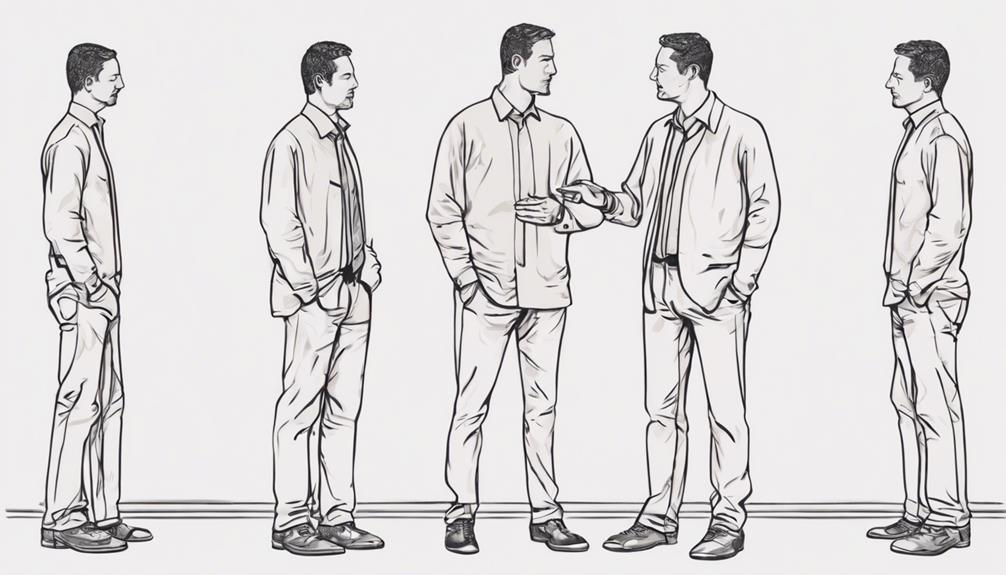Mastering advanced covert hypnosis techniques involves utilizing subtle communication cues, subliminal messaging, and strategic rapport-building tactics. These methods influence thoughts and behaviors effectively by establishing trust, using hypnotic language, and implementing anchoring techniques. By understanding NLP strategies and their application in covert hypnosis, one can shape outcomes through language patterns and belief systems. Learning the art of building rapport, leveraging subliminal messaging, mastering conversational hypnosis, implementing anchoring techniques, and practicing NLP strategies are essential in mastering advanced covert hypnosis techniques for successful influence. Explore the depths of these techniques for a deeper understanding of their potential impact.
Building Rapport and Trust

To effectively apply advanced covert hypnosis techniques, establishing a strong foundation of rapport and trust with the subject is paramount. Building connections through body language plays a significant role in achieving this. Non-verbal cues such as maintaining eye contact, mirroring the subject's gestures, and adopting an open posture can help create a sense of familiarity and comfort, essential for successful covert hypnosis.
Body language serves as a powerful tool in establishing rapport as it communicates unspoken messages that can enhance or detract from the connection between the hypnotist and the subject. By being attentive to the subject's body language cues, the hypnotist can adapt their own non-verbal communication to foster a better understanding and connection.
Moreover, building connections goes beyond just non-verbal cues. Active listening, empathy, and genuine interest in the subject's well-being are equally crucial. Demonstrating authenticity and sincerity in interactions can strengthen trust and rapport, laying a solid foundation for the effective application of advanced covert hypnosis techniques.
Utilizing Subliminal Messaging
Utilizing subliminal messaging involves embedding hidden suggestions or commands within various forms of communication to influence the subject's subconscious mind without their conscious awareness. This technique leverages unconscious influence and persuasive techniques to subtly shape the recipient's thoughts, feelings, and behaviors. Subliminal messaging operates on the premise that individuals can be influenced without their explicit knowledge, allowing for a deeper level of subconscious persuasion.
Through carefully crafted messages or imagery, subliminal messaging aims to bypass the conscious mind's filters, directly targeting the more receptive subconscious. By integrating these subtle cues into everyday interactions or media, practitioners of covert hypnosis can plant seeds of suggestion that may later manifest in the subject's decisions or beliefs.
When used ethically and responsibly, subliminal messaging can be a powerful tool for enhancing communication effectiveness and fostering positive outcomes. However, it is essential to approach this technique with caution and respect for the subject's autonomy and well-being.
Mastering Conversational Hypnosis

Mastering conversational hypnosis involves harnessing the power of language and non-verbal cues to subtly influence and shape the thoughts and behaviors of others in everyday interactions. Hypnotic language plays a crucial role in this technique, where words are strategically chosen to bypass the conscious mind and directly impact the subconscious. By using language patterns that induce a trance-like state, a skilled practitioner can guide the listener towards a desired outcome without their explicit awareness.
In addition to hypnotic language, effective persuasion tactics are essential in mastering conversational hypnosis. These tactics may include building rapport, mirroring body language, and subtly leading the conversation towards a predetermined goal. By creating a sense of trust and connection with the individual, the hypnotist can increase their receptiveness to suggestions and influence their decision-making process.
Implementing Anchoring Techniques
Implementing anchoring techniques involves strategically associating a specific stimulus with a desired emotional or behavioral response to influence future reactions. By leveraging emotional triggers and conditioning, individuals can establish powerful connections between stimuli and responses, ultimately shaping behavior and influencing outcomes. Anchoring operates on the principle that repeated pairing of a stimulus with a specific emotional state or behavior creates a link in the individual's mind, leading to automatic responses when the stimulus is encountered in the future.
In the realm of covert hypnosis, anchoring techniques play a crucial role in manipulating power dynamics and exerting influence over others. By anchoring positive emotions or desired behaviors to specific cues or gestures, practitioners can subtly guide individuals towards predetermined outcomes without their conscious awareness. This covert form of conditioning allows for the subtle shaping of reactions and decisions, ultimately leading to desired results in various situations.
Mastering anchoring techniques is a powerful tool for those seeking to enhance their persuasive abilities and influence others covertly.
Practicing NLP Strategies

An understanding of NLP strategies is essential for practitioners of covert hypnosis looking to enhance their communication and influence techniques. Neuro-linguistic programming (NLP) offers a framework for understanding how individuals structure their subjective experiences and provides tools for effective communication, persuasion techniques, and psychological manipulation.
By practicing NLP strategies, individuals can gain insights into how language patterns, sensory modalities, and beliefs shape human behavior, allowing for more precise and targeted subconscious influence.
NLP techniques can be applied in covert hypnosis to build rapport, establish trust, and subtly guide the thoughts and emotions of others. Through the use of language patterns that resonate with the listener's unconscious mind, practitioners can create a sense of alignment and receptivity, leading to increased influence and compliance.
Frequently Asked Questions
How Can I Ensure Ethical Use of Covert Hypnosis Techniques?
When utilizing covert hypnosis techniques, individuals must be vigilant in maintaining ethical boundaries by considering professional responsibilities, moral implications, and refraining from intentional manipulation. Upholding these principles safeguards against potential harm and ensures ethical practice.
What Are Common Pitfalls to Avoid When Using These Techniques?
When utilizing covert hypnosis techniques, it is crucial to avoid common pitfalls such as overconfidence and misinterpreting cues. Ethical use involves obtaining consent and maintaining honesty throughout the interaction to ensure ethical boundaries are upheld.
Can Covert Hypnosis Be Used for Self-Improvement Purposes?
Covert hypnosis can be utilized for self-improvement purposes such as self-confidence boosting and behavior modification. By understanding and applying these techniques effectively, individuals can enhance their mental attitudes and make positive changes in their behavior.
Are There Any Legal Implications of Using These Techniques?
When employing covert hypnosis techniques, it is crucial to navigate legal concerns and ethical boundaries. The use of such methods without consent or for manipulative purposes may lead to potential legal ramifications and breaches of ethical standards.
How Can I Protect Myself From Potential Manipulation by Others Using These Techniques?
Recognizing manipulation is crucial in safeguarding oneself from potential harm. Setting clear boundaries, practicing critical thinking, and enhancing communication skills can help individuals protect themselves from being manipulated by others using covert techniques.
Conclusion
In conclusion, mastering advanced covert hypnosis techniques requires a combination of building rapport, utilizing subliminal messaging, mastering conversational hypnosis, implementing anchoring techniques, and practicing NLP strategies.
By understanding and applying these techniques effectively, individuals can influence others' thoughts and behaviors in a subtle and persuasive manner.
Developing these skills can enhance communication and interpersonal relationships, ultimately leading to greater success in various personal and professional settings.
